

Web2py one to many database tutorial using SQLFORM.smartgrid – Pyguy. This web2py tutorial has everything you need to create a To Do list featuring a list of users stored in one table, a task database stored in another table, and how to create a one to many relation ship between a user and that user’s list of tasks.
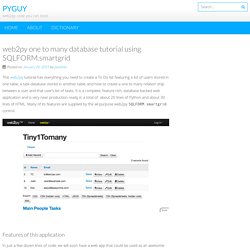
It is a complete, feature-rich, database-backed web application and is very near production ready in a total of about 20 lines of Python and about 30 lines of HTML. Many of its features are supplied by the all-purpose web2py SQLFORM.smartgrid control. Features of this application In just a few dozen lines of code, we will soon have a web app that could be used as an awesome prototype or even be deployed for internal use: You can enter, edit, delete, and search tasksYou can enter, edit, and create user (person) recordsRelations are enforced. GitHub - Sreya1/QuestionAnswer: A Q&A Portal implemented in web2py. GitHub - daxslab/web2py-typeahead: typeahead.js autocomplete widget for web2py. Managing Data Storage with Blockchain and BigchainDB. There’s no denying that whilst Bitcoin’s future may be hazy right now, the underlying technology it relies upon — the Blockchain — has revolutionized many industries and projects, with more to come.
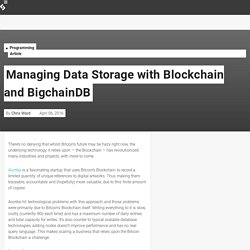
Ascribe is a fascinating startup that uses Bitcoin’s Blockchain to record a limited quantity of unique references to digital artworks. Thus making them traceable, accountable and (hopefully) more valuable, due to this finite amount of ‘copies’. Ascribe hit technological problems with this approach, and those problems were primarily due to Bitcoin’s Blockchain itself.
Writing everything to it is slow, costly (currently 80c each time) and has a maximum number of daily entries and total capacity for writes. It’s also counter to typical scalable database technologies, adding nodes doesn’t improve performance and has no real query language. Thanks to the Blockchain layer, BigChainDB also claims to be fully decentralized. Installing BigChainDB and Dependencies. Frequently asked questions - RethinkDB. Examples of applications written in Python. Next / Previous / Index / ITC Help System / Publications / Site map / NM Tech homepage Here are some examples of Python programming.
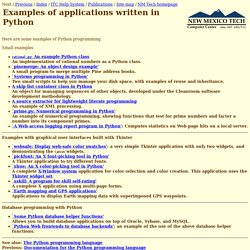
Small examples rational.py: An example Python class An implementation of rational numbers as a Python class. `pinemerge: An object design example' A small program to merge multiple Pine address books. `Systems programming in Python' Two small scripts to help you manage your disk space, with examples of reuse and inheritance. Examples with graphical user interfaces built with Tkinter `websafe: Display web-safe color swatches': a very simple Tkinter application with only two widgets, and demonstrating the Canvas widgets. Database programming with Python `Some Python database helper functions' Allows you to build database applications on top of Oracle, Sybase, and MySQL.
A Notepad like Text Editor designed in Python & Tkinter. Let’s see how we can design a simple text editor like notepad using Python.
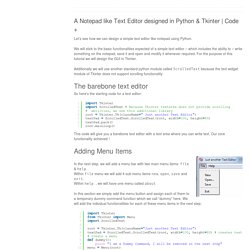
We will stick to the basic functionalities expected of a simple text editor – which includes the ability to – write something on the notepad, save it and open and modify it whenever required. For the purpose of this tutorial we will design the GUI in Tkinter. Additionally we will use another standard python module called ScrolledText because the text widget module of Tkinter does not support scrolling functionality. The barebone text editor. OpenClassrooms - Pour finir et bien continuer. La fin de ce cours sur Python approche.

Mais si ce langage vous a plu, vous aimeriez probablement concrétiser vos futurs projets avec lui. Je vous donne ici quelques indications qui devraient vous y aider. Ce sera cependant en grande partie à vous d'explorer les pistes que je vous propose. Vous avez à présent un bagage suffisant pour vous lancer à corps perdu dans un projet d'une certaine importance, tant que vous vous en sentez la motivation. Nous allons commencer par voir quelques-unes des ressources disponibles sur Python, pour compléter vos connaissances sur ce langage.
Nous verrons ensuite plusieurs bibliothèques tierces spécialisées dans certains domaines, qui permettent par exemple de réaliser des interfaces graphiques. Table des matières. Programmation en Python pour débutants. La première version de cette formation en ligne ouverte à toutes et tous (FLOT/MOOC) a été développée et mise en ligne en 2014 sous la conduite de Nathalie VAN DE WIELE, fondatrice de l’initiative sillages.info.
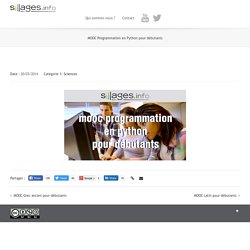
À qui s’adresse cette formation ? Cette formation, libre et gratuite, est destinée à tout·e apprenant·e désirant faire ses premiers pas en programmation, sans prérequis. En 2014, une première version de ce FLOT/MOOC, destinée notamment aux futurs étudiant·es des classes préparatoires scientifiques n’ayant pas suivi la spécialité de terminale S Informatique et sciences du numérique (ISN), était lancée. Codecademy.